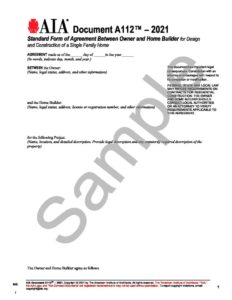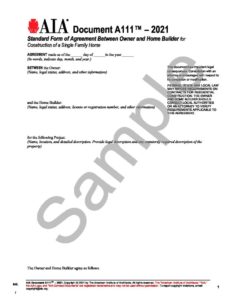
The American Institute of Architects (AIA) recently released two new AIA residential contract templates for home builders.
The A111 – 2021 is a contract between a homeowner and a home builder for the c onstruction of a single-family home. This contract was developed for projects where the construction documents have been completed or are beingcompleted under a separate agreement.
The A112 – 2021 is for the construction of a single-family home, and includes design services. The AIA already has a contract template (A145 – 2015) for design-build one- or two-family dwelling projects.
Benefits of using AIA contract templates
The AIA has been developing templates for contracts and other documents for over 130 years — so they are well-accepted by the industry. Although they have a reputation for producing documents that are more friendly to architects and designers, they rely on a team of professionals

Many lenders require the use of AIA contracts because they are highly respected and the terms and conditions are standard across all the contract templates.
Using an AIA contract helps you standardize the terms and conditions of your agreements. All of the terms of the AIA residential construction contract are included in the form, so you don’t have to worry about forgetting a key clause and having a problem later. Standardized terms and conditions are beneficial because you’ll always know what your contract says and won’t have to review it each time.
AIA templates are easy to use and complete. The templates are downloaded into Microsoft Word so you can edit all the language and complete the fields necessary for your contract. Instructions are provided for each of the areas that you need to complete.
Once you’ve edited the document, it’s finalized by the software and is converted into a PDF that can be printed or sent for signature.
The importance of a contract
Some builders still rely on a handshake when it comes to going to contract with their customers. While in most cases this works, some cities and states have particular requirements about terms that must be included in construction contracts. One way to ensure the necessary terms are included is to use a contract template.
In addition, most homeowners are not generally well-schooled in contracts or construction, so they may not understand everything in a contract document.
For example, lien rights are key for homeowners to understand so they aren’t surprised when they receive a preliminary notice.In some states, like California, residential builders must include specific language in the contract or provide a separate notice, as in Oregon. If you fail to provide the notice, the contract may be invalidated and/or you could lose your right to file a lien if you aren’t paid.
AIA home builder contract key sections
We’re going to go through some of the key sections that home builders need to be aware of, or that you’ll be required to provide information for, in the A111 and A112. Before using these templates, you’ll need to know what information goes where and the ramifications of including or excluding certain language.
Section 2.1 Consumer Protection Notice Requirements
Some states or jurisdictions may require contractors to provide consumer protection notices. Note that notices regarding mechanics liens are included in Section 2.3.
For example, in California, home improvement contractors are required to provide their customers with the following consumer protection notices:
- Extra Work and Change orders
- Commercial General Liability Insurance
- Workers’ Compensation Insurance
- Mechanics’ Lien Warning
- Contractor’s Board notice
- Cancellation Notice
Section 2.3 Mechanics Lien Notification Requirements
Certain states require that specific language regarding mechanics liens be included or that notices be attached to each contract. That language should be included here. If attachments are required, write “See attachments” in this space. Even if you aren’t required to provide any specific language here, you may want to spell out the lien process so that homeowners can understand the consequences of not paying for work they requested.
Tennessee requires contractors to include the following clause regarding mechanics liens:
“Delivered this ________ day of ____, 20_____, by _____________________, Contractor, “The above-captioned contractor hereby gives notice to the owner of the property being improved, that the contractor is about to begin improving the property according to the terms and conditions of the contract and that under the provisions of state law (§§66-11-101 – 66-11-141) there shall be a lien upon the real property and building for the improvements made in favor of the above-mentioned contractor who does the work or furnishes the materials for such improvements for a duration of one (1) year after the work is finished or materials furnished.”
In Texas, a general contractor is generally not required to give any preliminary notice. However, when a project is residential, a GC must provide a Residential Disclosure Statement, among other information.
The Residential Disclosure Statement is a lot easier than most other notices. It can basically just be copied and pasted from Tex. Prop. Code § 53.255 and be either included in the contract or provided as a separate document.
Section 2.4 Jurisdiction and Jurisdiction-Specific Requirements
Some jurisdictions may require specific language in the contract regarding municipal, flood, environmental protection, sustainability, historic preservation, zoning, or other unique or site-specific requirements.
Action 2.5 Other Statutory Requirements
Any other language or notifications that are required by statute or local law should be included here.
Section 2.6 Additional Requirements Upon Which the Agreement Is Based
These requirements may include property or site covenants, conditions, and restrictions, and homeowner’s association (HOA) requirements. Any specific documents should be attached to the contract.
Section 5.1.6 Builders Risk Insurance
Note that this section states that the builder will provide builders risk insurance for the total value of the entire project on a replacement cost basis. If the homeowner will be providing this coverage or it’s not part of your budget, be sure to change the language appropriately. If you don’t, you will be responsible for providing the insurance whether or not you’re being compensated for it.
Section 6.1 Binding Dispute Resolution
In this section, you select the type of dispute resolution that shall be used during the project if the parties cannot come to an agreement. The options are “arbitration,” “litigation,” and “other.” If no selection is made on the contract, claims will be resolved through litigation.
It’s important that both parties understand how claims will be settled if you cannot come to an agreement. Some jurisdictions may require mediation before arbitration or litigation as part of the process. This should be clarified in the contract accordingly.
Learn more – Construction Dispute Resolution: A Guide
Section 7.12 Indemnification
Indemnification clauses clarify who is responsible for what if a claim for damages should come up. Most contract clauses try to pass responsibility down the chain, to lower-tier subcontractors and suppliers. In the A111 contract, the home builder states that they are responsible for their work, the work of their subcontractors, and anyone directly or indirectly employed by them. It is recommended that you go over this language with the homeowner so they are aware of the extent of your liability for damages or other losses that may occur during the project.
Builders risk and general liability insurance provide coverage for activities that are outside the process of construction, such as weather events, vandalism, and theft. It’s important to require these policies in the contract and document that they are in effect before the project starts.
Section 8.1 Changes in the Work
Changes in the scope of work, called change orders, are always a part of construction. Whether it’s unforeseen conditions or a client who decides to make a change, they happen on almost every project. Be sure to review this section and its language to ensure that it meets your needs and will protect you from performing unapproved additional work.
Section 10.2 Time
This section states that if delays occur due to conditions outside the contractor’s control, a contract extension shall be granted. However, it doesn’t mention the recovery of additional costs for that extension, such as supervision, equipment rental, etc. If you’d like to be reimbursed for additional costs caused by a schedule extension, then include that language here.
Section 11.1.5 Payment Requirements
This section states that provided that the owner has paid all their bills, the contractor must defend them from mechanics liens and other claims. It also requires the homeowner to notify the contractor if they receive a lien or other claim for payment. Language regarding the contractor’s right to file a lien should be included in section 2.3.
In California, a down payment required on a Home Improvement Contract cannot be more than $1,000 or 10% of the contract amount, whichever is less, and the contract must include the following sentence in at least 12-point bold, CAPITAL type:
“THE DOWN PAYMENT MAY NOT EXCEED $1,000 OR 10 PERCENT OF THE CONTRACT PRICE, WHICHEVER IS LESS.”
To the extent the contract calls for progress payments, the section describing the progress payment schedule must include the following statement in at least 12-point bold type:
“The schedule of progress payments must specifically describe each phase of work, including the type and amount of work or services scheduled to be supplied in each phase, along with the amount of each proposed progress payment. IT IS AGAINST THE LAW FOR A CONTRACTOR TO COLLECT PAYMENT FOR WORK NOT YET COMPLETED, OR FOR MATERIALS NOT YET DELIVERED. HOWEVER, A CONTRACTOR MAY REQUIRE A DOWN PAYMENT.”
Contract templates provide consistency
Using contract templates makes creating consistent contracts easier and faster. The AIA Contract Documents are well respected in the industry and are approved by most lenders. Residential contractors still need to do the research to know what language needs to be included in their contracts, however.
As always, if you have any questions or concerns about a contract or a clause, it’s recommended that you consult an attorney.
